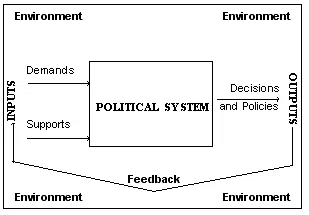Theories – Systems, Sontingency | Public Administration Optional for UPSC (Notes) PDF Download
| Table of contents |

|
| Organization |

|
| Systems Theory of Organization |

|
| Contingency Theory of Organization |

|
| Types of Organizations |

|
Organization
An organization can be defined as a system or framework that implements and executes the objectives and guidelines set by administration. It ensures the efficient use of resources, such as personnel, materials, and finances, to achieve goals. It consists of interacting elements that have specific functions, roles, and relationships within the organization. Although these elements work independently, they collaborate and coordinate with each other to accomplish their own goals as well as the goals of the organization.
In a family, which is a primary unit of organization, family members work together to achieve common objectives such as well-being and safety. Similarly, in business or governmental organizations, departments, ministries, offices, and employees collaborate according to the organization's rules and regulations to achieve organizational goals. This collaboration also helps individuals in achieving their own goals within the organization.
Systems Theory of Organization
- The systems theory of organization was initially developed in physics to explain how atoms combine to form molecules. It was later applied to fields such as political science, public administration, and management as a modern approach to understanding organizational dynamics. Proponents of this theory, such as David Easton and Chester Barnard, analyzed political and administrative systems to understand their structure and functioning, deriving optimal ways of operation through their studies.
- According to this theory, an organization is a system composed of interconnected elements that work together to perform specific functions. Each system influences its subsystems and is influenced by them. This theory rejects the notion of organizations as closed systems that are independent of their environment. Instead, it emphasizes the interdependence between organizations and their environment, highlighting the need for constant interaction and adaptation. It also challenges the classical theory of organization, which suggests that there is one best way of doing things, by supporting the concept of "equifinality" where different approaches can lead to the same desired outcome.

- The systems theory takes a holistic approach by considering all elements of an organization, including hierarchy, communication, personnel, procedures, and the interface with the environment. It emphasizes the interdependency between organizations and their environment, which is particularly relevant in today's complex and globally expanding organizations. While it may not provide solutions to all administrative problems, it helps generate awareness of the limitations and weaknesses of formal administration in addressing social and behavioral changes. This theory also critiques Max Weber's Ideal Bureaucracy theory, which views organizations as closed systems.
Contingency Theory of Organization
- Contingency theory asserts that there is no universally best way to organize a corporation, lead a company, or make decisions. Instead, the optimal course of action is contingent upon the internal and external circumstances faced by an organization.
- Key factors that organizations need to consider include technology, suppliers, distributors, consumer interest groups, customers, competitors, government, and unions. Contingency theory recognizes that organizations are open systems that require careful management to balance internal needs and adapt to environmental conditions. It highlights the importance of achieving alignment and good fit between organizational structures and the specific task or environment being dealt with. Different types of organizations are needed in different environments.
- According to William Richard Scott, contingency theory suggests that the best way to organize depends on the nature of the environment to which the organization must relate and adapt.
Types of Organizations
- Formal Organizations: Formal organizations are established with defined objectives. They have a clear structure that reflects the division of goals within the organization. Divisions, departments, positions, and tasks form the work structure of a formal organization. Formal organizations are expected to maintain impersonal relationships with clients and members. Merit or seniority is typically the basis for entry and advancement within the organization. Employees receive salaries and enjoy a degree of job security, protecting them from arbitrary influences. Formal organizations are characterized by bureaucratic structures that appoint heads or chiefs of administrative subdivisions, providing them with the authority associated with their positions.
- Informal Organizations: Informal organizations represent the social structure that governs how people work together in practice. They encompass behaviors, interactions, norms, personal and professional connections through which work is accomplished and relationships are formed among individuals sharing a common organizational affiliation. The informal organization arises spontaneously and evolves in response to changes in the work environment, the flow of people, and the complex social dynamics among members. Informal organizations exist within formal organizations and are interdependent. They foster personal connections among employees, which can enhance their motivation and productivity.
Conversely, within informal organizations, members also observe certain rules and regulations that define their group membership. While informal organizations may not have the same hierarchical structure and formal procedures as formal organizations, they still exhibit a level of organization and influence over how work is accomplished.
Formal and informal organizations are intertwined and interdependent. If one aspect is disregarded or eliminated, the other will inevitably disintegrate. Recognizing and understanding the dynamics of both formal and informal organizations is crucial for effective management and fostering a productive and harmonious work environment.

|
Explore Courses for UPSC exam
|

|


















